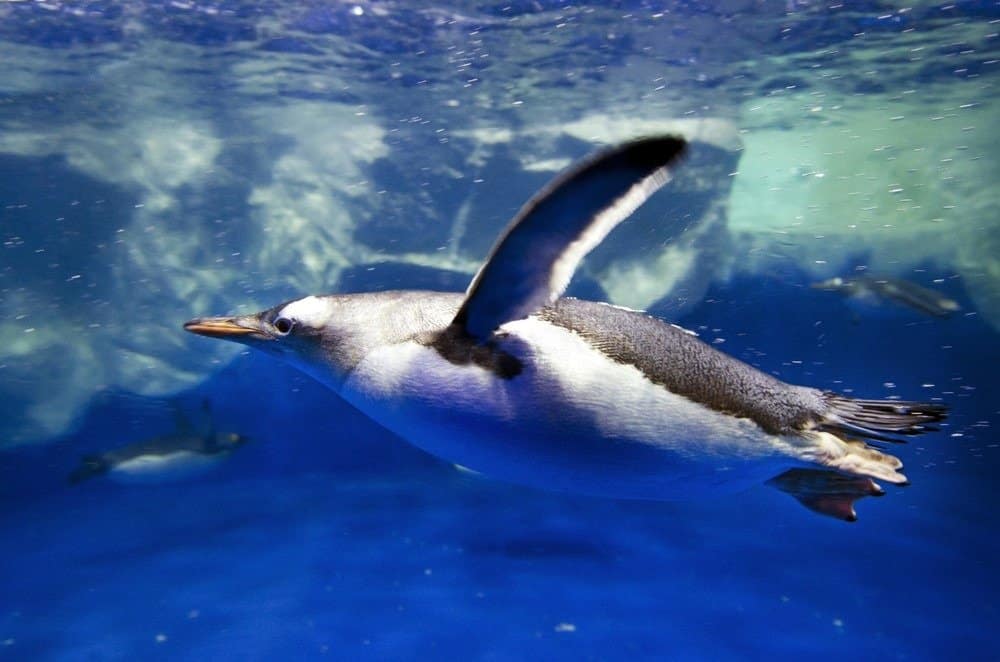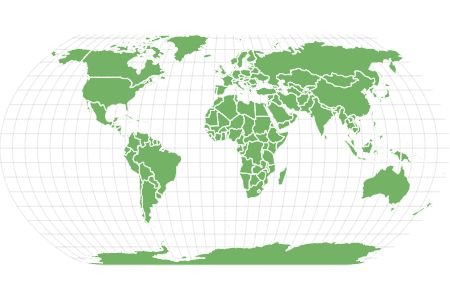Gentoo Penguin
.jumbotron {
background-image: url(“https://a-z-animals.com/media/gentoo-penguin-header-400×300.jpg”);
}
}
@media only screen and (min-width: 641px) and (max-width: 920px) {
.jumbotron {
background-image: url(“https://a-z-animals.com/media/gentoo-penguin-header-470×370.jpg”);
}
}
@media only screen and (min-width: 921px) {
.jumbotron {
background-image: url(“https://a-z-animals.com/media/gentoo-penguin-header.jpg”);
}
}
Gentoo Penguin
Pygoscelis papua
Found throughout the sub-Antarctic!
Gentoo Penguin Scientific Classification
- Kingdom
- Animalia
- Phylum
- Chordata
- Class
- Aves
- Order
- Sphenisciformes
- Family
- Spheniscidae
- Genus
- Pygoscelis
- Scientific Name
- Pygoscelis papua
Read our Complete Guide to Classification of Animals.
Gentoo Penguin Conservation Status
Gentoo Penguin Facts
- Main Prey
- Krill, Fish, Shrimp
- Distinctive Feature
- Small head with orange beak and feet
- Habitat
- Rocky Antarctic Islands
- Predators
- Leopard Seal, Killer Whale, Sharks
- Diet
- Carnivore
- Average Litter Size
- 2
- Lifestyle
-
- Colony
- Favorite Food
- Krill
- Type
- Bird
- Slogan
- Found throughout the sub-Antarctic!
This post may contain affiliate links to our partners like Chewy, Amazon, and others. Purchasing through these helps us further the A-Z Animals mission to educate about the world’s species..

Spiders that fly! Fish that walk! And 1000+ more incredible animals. Discover them all for FREE
.photo-gallery {
–margin: 0px auto 0px;
–padding: 0px 0px 0px 0px;
}
.gallery-link {
background-image: url(“https://a-z-animals.com/media/animals/images/original/gentoo_penguin.jpg”);
background-repeat: no-repeat;
background-size: cover;
background-position: center;
height: 500px;
justify-content: center;
text-align: center;
align-items: center;
display: flex;
border: 2px solid #000;
}
.gallery-link img {
height: 50%;
}
@media only screen and (max-width: 768px) {
.gallery-link {
height: 300px !important;
}
}
View all of the Gentoo Penguin images!
“The Gentoo Penguin is known to be the fastest swimming penguins in the world”
The Gentoo Penguins are, much like the other penguin species, black in appearance from the back to the head. They also adorn a white belly and are most commonly distinguished by a white stripe that runs from eye-to-eye at the top of their heads.
Gentoo Penguins are often relaxed and laid back. They are rarely aggressive. However, they do have some loud moments during their nesting period. They are the only ones in the engine species that are known to be increasing in domain size as well as in numbers.
button.pulse {
transform: scale(1); animation: pulse 2s infinite;
box-shadow: 0 0 0 0 rgba(11, 247, 25, 1);
}
@keyframes pulse {
0% { transform: scale(0.90); box-shadow: 0 0 0 0 rgba(11, 247, 25, 0.5); }
60% { transform: scale(1); box-shadow: 0 0 0 15px rgba(11, 247, 25, 0); }
100% { transform: scale(0.90); box-shadow: 0 0 0 0 rgba(11, 247, 25, 0); }
}
Incredible Gentoo Penguin Facts!
- Gentoo Penguins are known to be the third-largest penguins in the world – after the emperor and king penguins.
- Gentoo Penguins, when diving in deep waters, often control and reduce their heartbeat considerably. It can very well go from 80 to 100 heartbeats per minute to 20 heartbeats per minute.
- Gentoo Penguins are known to be the fastest swimming penguins in the world. These penguins learn to swim without any help from their parents.
- These are very relaxed creatures and are rarely ever aggressive.
- These penguins use a variety of materials during their nesting period. The materials can range from molten feathers to pebbles.
- Males and females usually take turns to incubate their eggs. These penguins are also known to mate with the same partners year on year.
Gentoo Penguin Scientific name
The scientific name of the Gentoo Penguin, belonging to the genus Pygoscelis, is Pygoscelis papua. They belong to the class of birds and reptiles.
However, the origin of the word Gentoo has so far been unclear. Some say that the word was used by the Anglo-Indians to distinguish between Hindus and Muslims.
Another theory states that the name might have come from some turban related term as the white patch on the penguin’s head is said to be a semblance to a turban.
Gentoo Penguins can further be divided into two subspecies. These are named Pygoscelis papua papua – which is the bigger one and the Pygoscelis papua ellsworth – which is the smaller one.
Gentoo Penguins Appearance and Behavior
From back to the head, the Gentoo Penguins are black with a white patch on their belly. They also have a white stripe that runs from their eye to eye at the top of their head.
These penguins have webbed feet that are pinkish-white in color. They also have a tail that is considered to be the longest amongst the Penguin family. They also have flippers on the underside that are pinkish. The Gentoo Penguins are the only known penguins to mankind with a bright orange bill.
The adults have very distinct eye patches while the younger ones have relatively dull patches. Upon birth, these penguins are grey and slowly turn on to become white within a week. The Gentoos are usually 30 to 36 inches in height and might weigh more than 18 pounds.
Behavior-wise, these penguins are usually laid back and are hardly ever aggressive. They are also known to be shy and usually do not make any effort to mark and/or defend their territories.

ChameleonsEye/Shutterstock.com
Gentoo Penguin Habitat
Gentoo Penguins are known to be found in a variety of regions. However, they are mostly found in the Southern Hemisphere. The Antarctic Peninsula and the sub-Antarctic Islands are the best for them to thrive. Their bodies are designed to maintain a certain temperature range for them to survive the low temperatures in their environment.
However, they almost always end up breeding in areas where no ice exists. They are widely distributed in southern latitudes, but their habitats are not in one common place and can vary from place to place. The Ellsworth’s Gentoo Penguins often stick to the coasts of Antarctica where they live as well as breed.
In some areas, the Gentoos often prefer beaches with loads of pebbles. In other areas, these penguins might find comfort in twigs-laden areas with seaweed.
Gentoo Penguin Diet
The Gentoo Penguins find every opportunity they can to hunt for food and feed themselves and their clans. Their diet includes fish, squid as well as crustaceans.
While fish make up about 15% of their diet, the Gentoo penguins hunt down krill. However, the diet also depends on where the creatures are in that particular season. They are known to spend most of their day hunting and sometimes also venture too far off places in search of food.
Gentoo Penguin Predators and threats
Usually, the leopard seals, orcas, and sea lions are the creatures who prey on these penguins. However, this is only common near water bodies. On land, these penguins have no threat except that from humans. Mankind has often hunted for them in search of oil and skin. Several birds also like to prey on Gentoo penguins.
These are the only penguins known to us that are increasing both in domains and numbers by the day. While they have been found to grow in numbers in the Antarctica region, on some islands, they are also reducing owing to the climate change problems. In 2007, they had received a near-threatened status by the International Union for Conservation of Nature.
Gentoo Penguin Reproduction, Babies, and Lifespan
These penguins usually mate with the same partners every year, after which, in September or October, they lay two eggs at a gap of about three days. The eggs, the second of which is always smaller than the first, usually hatch five weeks after they are laid. Till then, the parents take turns to guard as well as incubate the eggs.
The Gentoo penguin parents are very protective and nurturing in nature. Both the parents work in close coordination to build a nest for their little ones. After the eggs hatch, the babies remain in the nest for up to a month while the parents continue with their protective duties.
The babies, or penguin chicks, usually end up forming their nurseries or creches during their early childhood. Usually around January, around three months after they are born, the chicks start developing the adult feathers and going out on their own.
However, sadly, their survival often depends on food availability. If ever, a situation relating to the lack of food arises, the parents might have to decide to feed the stronger of their babies while making a tough choice to sacrifice their relatively weaker baby.
The lifespan of Gentoo Penguins is a total of 13 to 15 years. Surprisingly, the toughest battle for life is often fought within their first year of life with only about 30 to 50 percent chances that they will make it to the next.
Gentoo Penguin Population
The Gentoo penguins are the only penguins that are known to be increasing in numbers and domains by the day. According to sources, the breeding population of the Gentoo penguins currently stands at over 3,80,000 pairs.
However, the population of these penguins depends on and varies from region to region. For instance, in the Antarctica region, the penguin population has been increasing while in parts of the Indian Ocean, the population has been on a decrease.
The IUCN had, in 2007, declared the Gentoo Penguins as near threatened creatures.
Gentoo Penguin in the Zoo
Gentoo Penguins can often be kept in zoo environments and can often easily blend with minimal problems. Sources suggest that as of now, there are more than 750 Gentoo Penguins that live in zoos all around the world.
View all 115 animals that start with G
Gentoo Penguin FAQs (Frequently Asked Questions)
What is Gentoo Penguin?
Gentoo Penguins are creatures that are a part of the penguin families and are known as the fastest swimming penguins. They are distinguished by a white stripe that suns from their eye to eye.
Are Gentoo Penguins endangered?
No, they are not. They are, in fact, the only known penguins that are known to be increasing in numbers and domains. However, while in some regions, their population is increasing, in some other regions, it is also decreasing drastically. They were declared ‘nearly threatened’ by the IUCN in the year 2007.
How did these penguins get their name?
Well, the origin of their name might not be known but it is often said that they get their Latin name from the style of their tails that are longer as compared to the other penguins.
Is there a unique feature related to the Gentoo penguins?
Black in color from back to head, the Gentoo Penguins are most distinguished by the white strip at the top of their head that runs from eye to eye. Otherwise, they have a white patch on their bellies much like the other penguins.
How fast does the gentoo penguin swim?
The Gentoo penguins are known to be the fastest swimming penguins. They can swim about 22 miles per hour.
Are gentoo penguins carnivores, herbivores, or omnivores?
Gentoo penguins are usually carnivores.
How long do Gentoo Penguins live?
Gentoo penguins usually live for 13 to 15 years.
What does Gentoo Penguins eat?
The Gentoo penguins usually eat fish. About 15% of their diets comprise of fish. However, depending on the season and the place that they’re currently in, these penguins eat what they can find.
How tall are Gentoo Penguins?
Gentoo Penguins are usually 30 inches tall.
What Kingdom do Gentoo Penguins belong to?
Gentoo Penguins belong to the Kingdom Animalia.
How do Gentoo Penguins have babies?
Gentoo Penguins lay eggs.
Sources
- David Burnie, Dorling Kindersley (2011) Animal, The Definitive Visual Guide To The World’s Wildlife
- Tom Jackson, Lorenz Books (2007) The World Encyclopedia Of Animals
- David Burnie, Kingfisher (2011) The Kingfisher Animal Encyclopedia
- Richard Mackay, University of California Press (2009) The Atlas Of Endangered Species
- David Burnie, Dorling Kindersley (2008) Illustrated Encyclopedia Of Animals
- Dorling Kindersley (2006) Dorling Kindersley Encyclopedia Of Animals
- Christopher Perrins, Oxford University Press (2009) The Encyclopedia Of Birds
- National Geographic, Available here: https://www.nationalgeographic.com/animals/birds/g/gentoo-penguin/
- Oceanwide Expeditions, Available here: https://oceanwide-expeditions.com/to-do/wildlife/gentoo-penguin
- Wikipedia, Available here: https://en.wikipedia.org/wiki/Gentoo_penguin
- Seaworld Parks & Entertainment, Available here: https://seaworld.org/animals/facts/birds/gentoo-penguin/
- Travel Wild Expeditions, Available here: https://travelwild.com/wildlife/antarctica-wildlife/gentoo-penguin/
- Animal Diversity Web, Available here: https://animaldiversity.org/accounts/Pygoscelis_papua/
- Australian Antarctic Program, Available here: https://www.antarctica.gov.au/about-antarctica/animals/penguins/gentoo-penguins/
















